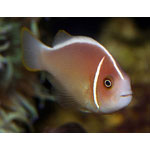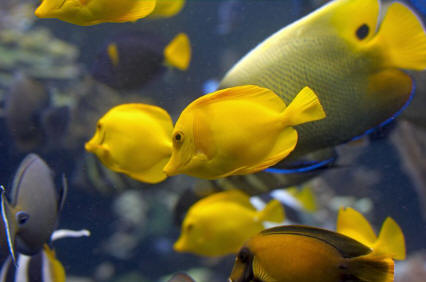Pink Skunk Clown

|
Scientific Name: Amphipirion perideraion Price: Upon Request Origin: Indo-Pacific Family: Pomacentridae NOT AVAILABLE NOW |
|
Other Names: Amphipirion perideraion, Pink Skunk Clownfish, Pink Skunk Anemonefish, False Skunk-striped Anemonefish, Pink Clownfish, Pink Anemonefish |
|
Technical Info
Temperature: 22 - 26 ℃
pH: 8.1 - 8.4
GH: 8 - 12
SG: 1.020 - 1.025
Max size: 11 cm
Min Tank size: 110 Ltr
Position in Aqua: Bottom swimmer
Description
The Pink Skunk Clown has a peach-orange base color with one white stripe behind the head that runs from the nose and down the entire length of the back. Another contrasting white stripe is located just behind the eyes.
Food
An omnivore. Should be fed a varied diet of meaty crustacean fares, such as finely chopped frozen or fresh table shrimp, fresh brine and mysid shrimp, as well as suitable herbivore preparations. A high quality, vitamin-enriched, color-enhancing marine omnivore flake food can be given to supplement adequate levels of nutrients. Feed 2 to 3 times per day.
Breeding
Pink Skunk Clown readily spawns in captivity. The female pink skunk clownfish will lay her eggs near her anemone, often on rocks or rubble. The pair will engage in side-by-side swimming and belly-touching prior to spawning. The female pink skunk clownfish presses her abdomen against the nesting site and moves over the area, depositing her eggs. The male pink skunk clownfish will swim behind her and fertilize the eggs. He may also revisit the nest when the female pink skunk clownfish is absent and fertilize them again. The pink skunk clownfish spawns all year, laying eggs approximately once per month. The hatch rate is high in the pink skunk clownfish, but survivorship of the larvae is often low. The pink skunk clownfish eggs hatch on the seventh evening after spawning at a temperature of around 27 degrees Celsius.
Compatible with
The pink skunk clownfish is one of the least aggressive members of the anemonefish group. The pink skunk clownfish normally lives harmoniously in groups, but it will occasionally behave aggressively toward conspecifics in order to maintain its social status. The pink skunk clownfish’s place in the pecking order is a function of size – the larger it is, the more dominant it tends to be. The largest fish is usually the female. The pink skunk clownfish tends to be subjugated by other damselfish, hawkfish, dottybacks and other aggressive substrate-bound fish species.
Note
The Pink Skunk Clown is a relatively hardy species and an aquarium bred specimens can be a suitable beginner fish for those who want to try to keeping marine fish as it is cheap as well. This species thrives without an anemone which makes it an even better choice for those who want to keep their first saltwater fish.

